Reserve Bank of Australia Annual Report – 2020 Banknotes
The Reserve Bank is responsible for producing and issuing Australia's banknotes. In this role, the Bank ensures there are sufficient banknotes on issue to meet public demand, that banknotes in circulation are of high quality, and that the threat of counterfeiting is minimised. The new $20 banknote was released in October 2019, with the final denomination in the upgraded series, the new $100 banknote, expected to be released in late 2020. The COVID-19 pandemic presented challenges for the issuance of banknotes when lockdowns to contain the spread of the virus affected transport services across the country. In response, the Bank enacted contingency arrangements for a short period to maintain adequate supply of banknotes to the public. The Bank also drew on its extensive stocks to meet increased public demand for high-denomination banknotes as a store of value and for precautionary purposes, a development that is common during periods of acute economic and financial uncertainty.
Circulation
Banknotes in circulation increased sharply with the outbreak of the COVID-19 pandemic in Australia. From mid March to the end of June 2020, some $7.7 billion in $50 and $100 banknotes were purchased from the Reserve Bank by commercial banks to meet public demand. This equates to over 8 per cent of the total value of banknotes in circulation and three-quarters of the increase in the value of circulating banknotes for the 2019/20 financial year. The increase in high-denomination banknotes in circulation occurred against the backdrop of reduced use of banknotes as a means of payment, implying an increased desire in the community to hold banknotes for precautionary purposes, including as a store of wealth. Similar shifts in demand were evident in other countries and are common during episodes of heightened economic and financial uncertainty as the community seeks to hold extra cash as a precaution. As at the end of June 2020, there were 1.8 billion banknotes in circulation, worth $90.1 billion. The value of banknotes in circulation increased by 12.6 per cent over 2019/20, compared with annual growth of around 5 per cent in recent years.
While store-of-value demand for high-denomination banknotes increased the value of banknotes in circulation, the COVID-19 outbreak reduced demand for lower-denomination banknotes, accelerating a decade-long trend away from using cash for making day-to-day payments. The Reserve Bank's 2019 Consumer Payments Survey – which was undertaken prior to the emergence of COVID-19 in Australia – showed that 27 per cent of consumer payments were made with cash, compared with 37 per cent in 2016 and 69 per cent in 2007.[1] From March 2020, transactions using cash fell sharply in favour of electronic payments in response to consumer and merchant concerns about potential transmission of the virus through handling cash. The Bank responded to a number of public enquiries about the potential health risks of using cash, recommending that banknotes be treated like other surfaces and to follow good hand hygiene consistent with Department of Health guidelines.

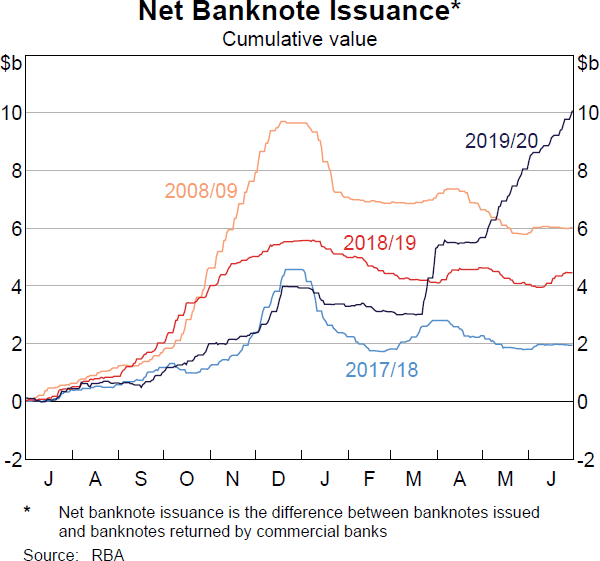
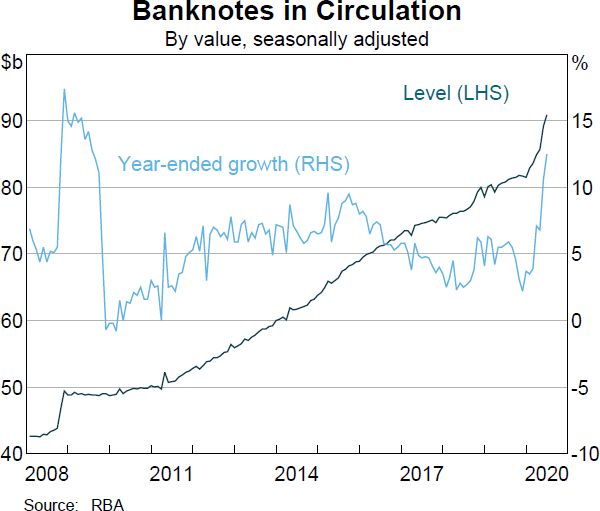
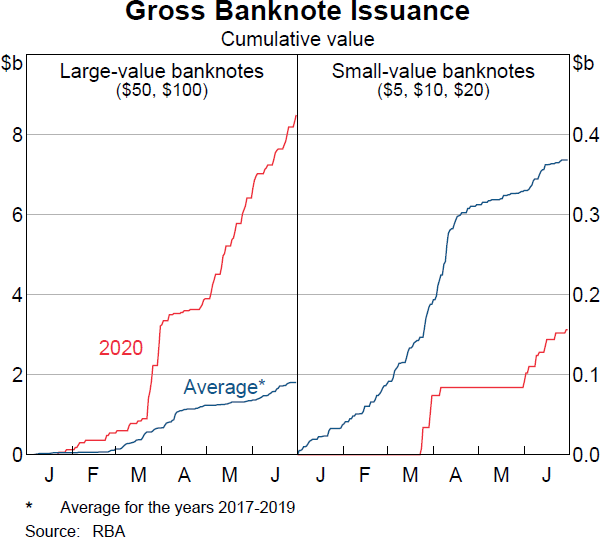
Distribution and Storage
The Reserve Bank operates as a wholesaler of banknotes, issuing banknotes to commercial banks, which, in turn, have arrangements in place to distribute banknotes around the country to meet the demands of their customers. In 2019/20, the Bank issued $14.7 billion worth of banknotes. Of these, $11.6 billion were new and $3.1 billion were banknotes that had previously been in circulation but had since returned to the Bank and were deemed fit for re-issue. As noted above, the bulk of this distribution activity – around $7.9 billion – occurred in the final few months of the financial year following the outbreak of COVID-19.
Since the opening of the Reserve Bank's purpose-built National Banknote Site (NBS) in Victoria, it has become the primary centre for the Bank's processing, distribution and storage of banknotes. The distribution site in Sydney was closed for business-as-usual distribution activities in late 2019, although it retains a holding of banknotes as a contingency in the event that the NBS is unavailable or cannot be easily accessed. The contingency arrangements at the Sydney site were activated for two weeks in late March 2020 in response to heightened demand for banknotes in the face of domestic transport restrictions associated with COVID-19. Concerns about transport eased in early April and the Bank's Sydney site returned to being a contingency-only site for the remainder of 2019/20.
The Reserve Bank aims to maintain a high quality of banknotes in circulation. High-quality banknotes are more readily handled by machines and make it more difficult for counterfeits to be passed. Accordingly, the Bank has arrangements that encourage the commercial banks and the cash-in-transit companies to sort the banknotes they handle to agreed quality standards. Based on this sorting, banknotes that remain fit for circulation get redistributed, while those that are deemed unfit get returned to the Reserve Bank. These unfit banknotes are assessed to confirm their authenticity and quality and are then shredded. In 2019/20, the Bank received $4.1 billion worth of banknotes deemed to be unfit for recirculation.
The Reserve Bank also removes banknotes from circulation through its Damaged Banknotes Facility. The facility is offered to members of the public who unwittingly have come into possession of damaged banknotes or whose banknotes are accidentally damaged. Claims that meet the requirements set out in the Bank's Damaged Banknotes Policy are paid based on their assessed value.
In 2019/20, the Bank processed around 11,500 claims and made $3.4 million in payments. Of these, 34 claims worth around $190,000 were received from members of the public whose banknotes were damaged during the Australian 2019/20 bushfires. To increase awareness of this service with the communities affected by the bushfires, the Bank shared information about how to lodge claims for bushfire-affected banknotes through the banknotes website, social media posts and media interviews. As it may take some time for affected members of the public to lodge a claim, and for commercial banks to deliver them to the Reserve Bank, assessment of claims from the bushfires is likely to continue into 2020/21.
Counterfeiting Rates
The level of counterfeiting in Australia remains relatively low by international standards. In 2019/20, around 21,000 counterfeits, with a nominal value of $1.6 million, were detected in circulation. This corresponds to around 13 counterfeits detected per million genuine banknotes in circulation.
Law enforcement efforts to investigate and prosecute counterfeiting operations play a significant role in managing the threat of counterfeiting. When counterfeit banknotes are sent to the Reserve Bank's Counterfeit Examination Laboratory, they are assessed by specialised document examiners. Counterfeits that are considered to be made by the same production source are grouped, monitored and referred to the Australian Federal Police (AFP) for investigation. The AFP, state police forces and the Commonwealth Director of Public Prosecutions all work to investigate and prosecute counterfeiting operations, with information and expert witness statements often provided by the Bank. In 2019/20, the Bank completed 207 statements relating to 2,564 counterfeits. In addition, the Bank is aware of 19 prosecutions that occurred during the year relating to the possession, passing and making of counterfeit currency.
| $5 | $10 | $20 | $50 | $100 | Total | |
|---|---|---|---|---|---|---|
| Number | 29 | 27 | 244 | 9,821 | 11,353 | 21,474 |
| Nominal value ($) | 145 | 270 | 4,880 | 491,050 | 1,135,300 | 1,631,645 |
| Parts per million | 0.1 | 0.2 | 1.4 | 12.4 | 29.9 | 12.6 |
Source: RBA |
||||||
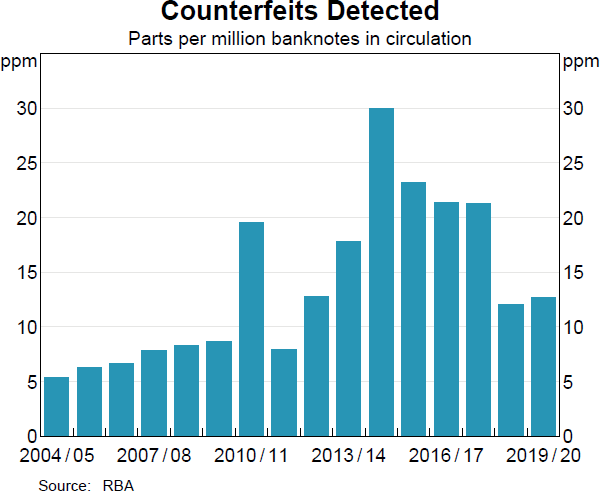
At times, police operations are able to prevent counterfeit banknotes from entering into general circulation. In 2019/20, police seizures of counterfeits accounted for 9 per cent of all counterfeits detected, in line with the long-run average.
Next Generation Banknote Program
To ensure that Australian banknotes remain secure against counterfeiting, the Reserve Bank has been issuing an upgraded series of banknotes. The new $5 banknote was released in 2016, the new $10 in 2017, the new $20 in 2019, and the new $50 in 2018. The new $20 banknote, released in October 2019, features portraits of Mary Reibey and Reverend John Flynn. Flynn was the founder of an aerial medical service that later became Australia's Royal Flying Doctor Service and which remains the largest and most comprehensive aeromedical emergency and healthcare service in the world. Reibey was a colonial entrepreneur who also became known for her support of charity, religion and education. The microprint on the new $20 features excerpts from Flynn's book, The Bushman's Companion, and the names of Reibey's ships.
The remaining denomination, the new $100 banknote, is scheduled to enter general circulation in late 2020. The Reserve Bank revealed the design of the new $100 banknote in February 2020. The new $100 continues to feature Dame Nellie Melba, an internationally renowned soprano, and Sir John Monash, an engineer, soldier and civic leader. The issuance of the new $100 banknote will bring the Next Generation Banknote Program to a conclusion; this program has been a feature of the Reserve Bank's work for more than 10 years. By the end of June 2020, approximately 1.4 billion Next Generation Banknotes had been printed.
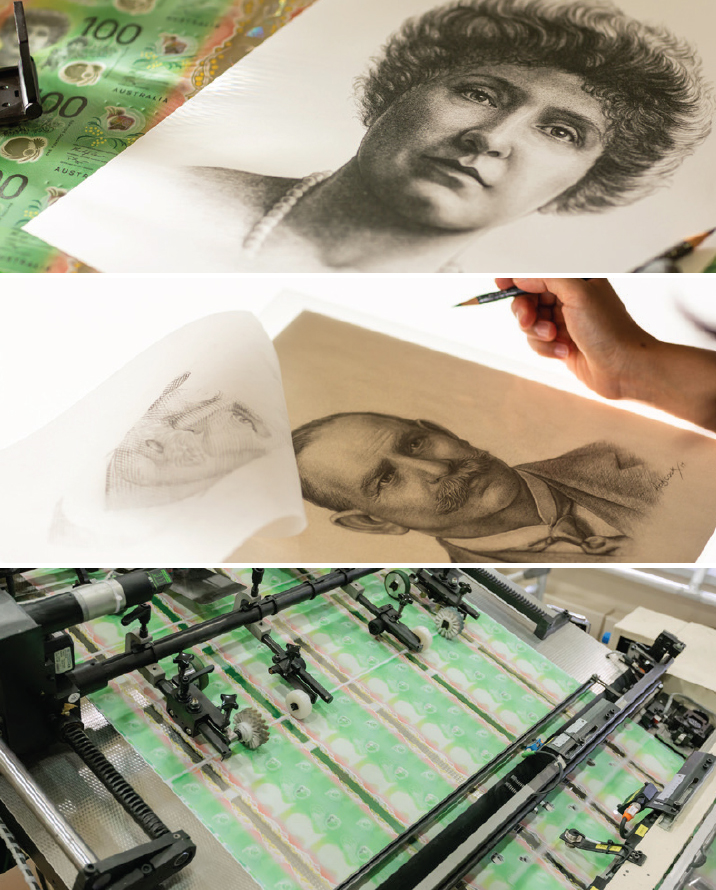
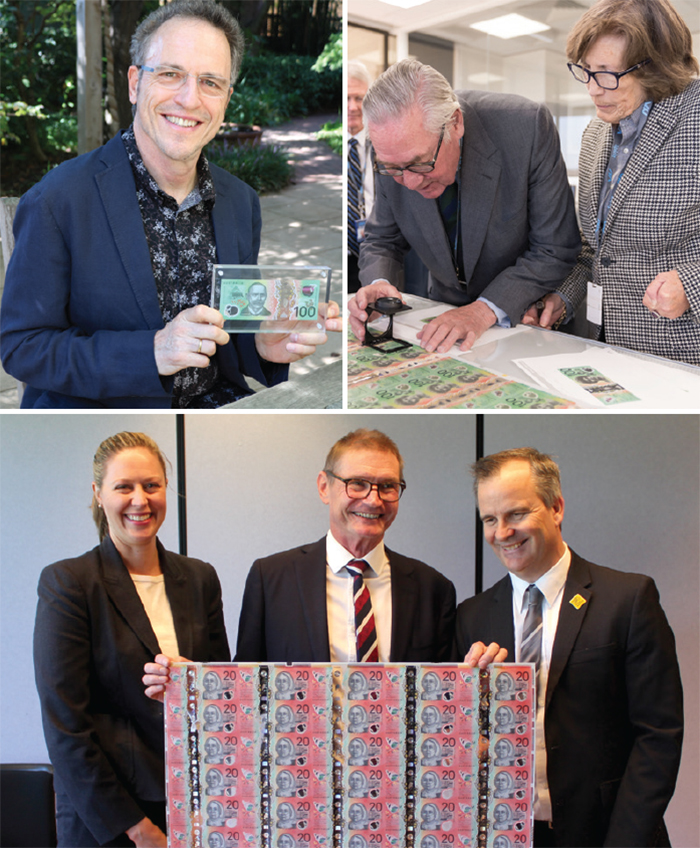
Photo: Vision Australia
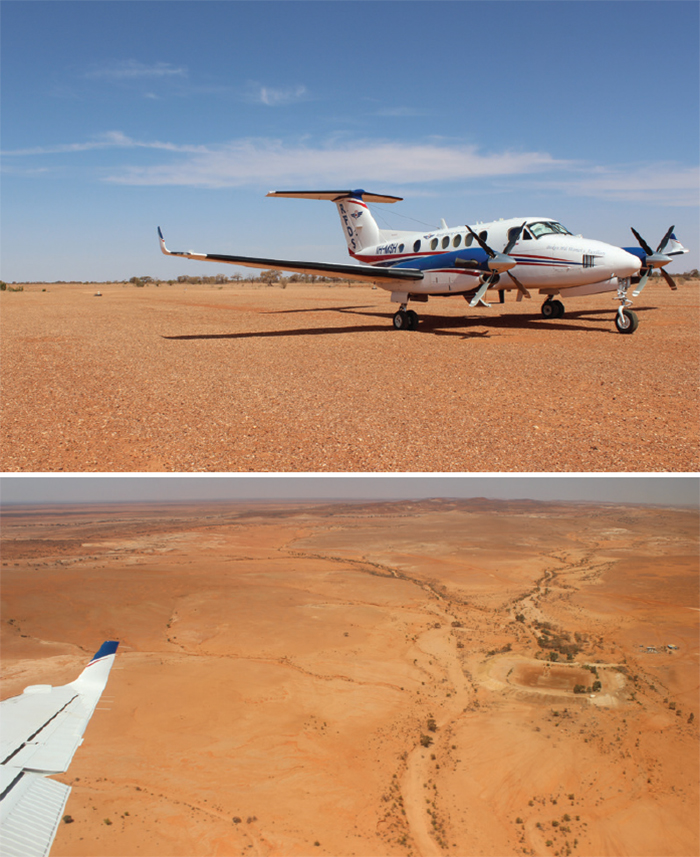
The new banknotes incorporate a range of new security features that make them considerably more difficult to counterfeit. These features include the top-to-bottom window, which contains optically variable images, including a flying bird and reversing number, as well as an ink patch with a rolling colour effect. The new banknotes also retain many of the key design elements of the first polymer banknote series, including the people portrayed, size and colour palette.
During 2019/20, the Reserve Bank continued to engage with industry and members of the public to increase knowledge about the new and existing banknotes. Some of these events focused on celebrating the contribution of stakeholders who have lent their expertise to the Bank throughout the design process for the new $20 and $100 banknotes, including the Royal Flying Doctor Service and relatives of Melba and Monash. In October 2019, members of the vision-impaired community had an opportunity to explore features of the new $20 banknote at a preview event at Vision Australia in Melbourne.
The Reserve Bank's communication with the cash-handling industry – which includes equipment manufacturers, financial institutions and other high-volume cash handlers, such as retailers and hospitality venues – has been an important component of the Next Generation Banknote Program. The Bank has engaged in regular communication (including via an online central hub of information) to support equipment upgrades and educate cash-handling staff and customers about the new banknote series. The Bank has continued its engagement with manufacturers and owners of banknote-processing machines to help ensure the machines are ready for the launch of the new $100 banknote.
Research and Development
The Reserve Bank has a banknote research and development (R&D) program focused on new banknote security features and detection equipment. The primary aim of this program is to ensure that Australia's banknotes remain secure against counterfeiting and easy to authenticate for a wide variety of users. This is achieved in part through collaboration with domestic and international experts from various external organisations, including universities, public and private companies, research institutes and other central banks. Fundamental to this program is a continuing assessment of the vulnerability of banknotes to different forms of counterfeiting, the mechanisms by which banknotes wear in circulation, production capability, and how the public and banknote-processing machines use and authenticate banknotes.
The Reserve Bank also works closely with its partners and suppliers to evaluate and incorporate new technologies and features into the banknote production process. In 2019/20, the R&D program continued to focus on providing technical advice and expertise as part of the development of the new series of Australian banknotes. This included assessing new technologies, developing strategies to ensure new features are durable, and developing quality-control systems for banknote examination. The R&D program is complemented by the design and manufacture of new instrumentation for quality assurance and the development of testing methodologies for the assessment of banknotes.

Note Printing Australia Limited (NPA)
NPA is a wholly owned subsidiary of the Reserve Bank that produces banknotes and supplies other related services to the Bank and some other entities. In 2019/20, NPA delivered 331 million Australian banknotes to the Bank, comprising around 221 million new series $50 banknotes, around 43 million new series $20 banknotes and around 67 million new $100 banknotes. In comparison, in 2018/19, 428 million Australian banknotes were delivered to the Bank by NPA.
The aggregate amount paid by the Reserve Bank to NPA in 2019/20 for the supply of banknotes and related services was $90 million, compared with $101 million in the previous year.
In addition, NPA delivered 149 million banknotes under contract to Papua New Guinea, Singapore, Brunei and Malaysia in 2019/20, dealing directly with the respective central banks in those countries. NPA also produced 1.9 million P Series passports for Australia's Department of Foreign Affairs and Trade.
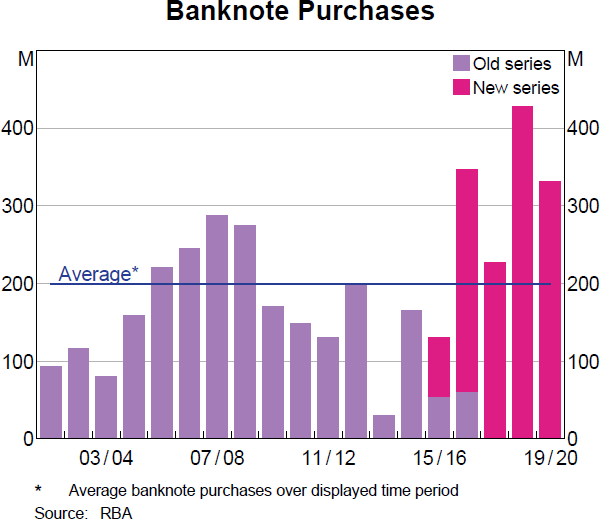
Footnote
For additional information see: Caddy J, L Delaney, C Fisher and C Noone (2020), ‘Consumer Payment Behaviour in Australia’, RBA Bulletin, March 2020. Available at: <https://www.rba.gov.au/publications/bulletin/2020/mar/consumer-payment-behaviour-in-australia.html>. [1]